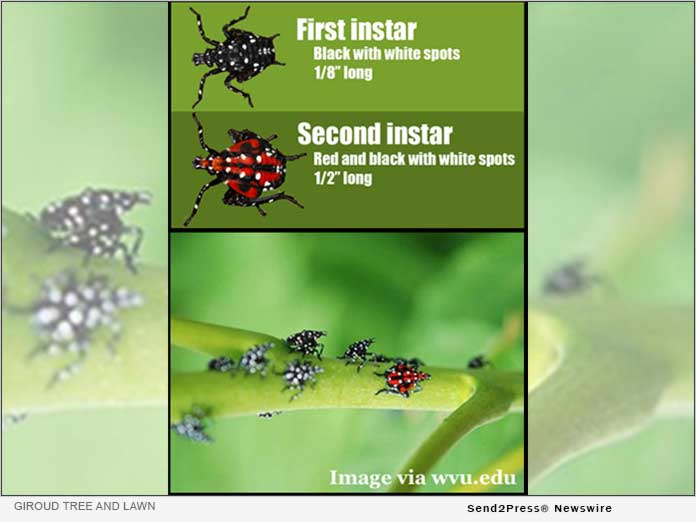
HUNTINGDON VALLEY, Pa., Jun 22, 2020 (SEND2PRESS NEWSWIRE) — The Spotted Lanternfly is a destructive insect that has invaded the Philadelphia area. All winter long, their eggs lay waiting for the warm weather, carefully encased in a protective, hardened layer of secretion. Now that they’ve emerge as nymphs, it’s time to take action!
How to Identify Spotted Lanternfly Nymphs
Spotted Lanternfly goes through several identities during its life cycle. Adult females lay eggs in the fall, and they cover the egg masses in a secretion. This secretion dries hard and camouflages to look like dirt or clay. The young nymphs that emerge from the eggs in spring are black with white spots. In early summer, they gain red markings on their bodies. Later in midsummer, they become adults and shed their skin to form wings on their backs.
How to Get Rid of Spotted Lanternfly Nymphs
The experts at Giroud Tree and Lawn have been working closely with Penn State University’s Department of Entomology and Cooperative Extension to determine the best treatments and techniques for combating Spotted Lanternfly in each of the life cycle stages. Chemical spray treatments are only recommended if there are high populations of nymphs on a specific plant or tree.
Chemical Control Treatments During the Nymph Stages
Research shows that the best time to control Spotted Lanterfly is at the adult stage. However, there is an exception. Nymph control may be warranted if the population is high enough to cause feeding damage (wilting stems). Or, if Nymphs are focusing heavily on individual plants. In these cases, homeowners should have an ISA Certified Arborist evaluate the situation and determine if targeted treatment is required.
Control of Spotted Lanternfly Nymphs is usually not warranted because nymphs love to move around. The young insects don’t stay on a single plant for long. To reach all the plants that might attract nymphs, the entire yard would have to be treated with a long, residual contact spray insecticide. Even with these treatments, nymphs can still invade from other locations!
Also, although insecticide will kill Nymphs, it can also kill beneficial insects and pollinators, such as bees and butterflies. The insect experts at Giroud prefer to use these types of sprays for targeted control, not broad scale treatments.
What’s the Solution for Controlling Spotted Lanterfly Nymphs?
Ultimately, the best way to combat Spotted Lanternfly during the Nymph Stage is with manual methods. Sticky bands, Circle Traps, and good old fashioned squishing are key to getting ahead of these awful insects before they reach adulthood.
Sticky bands can be found at most hardware stores and also on Amazon.com. They are easy to install, but they should be changed weekly for the best results. However, it is important to be aware that these sticky bands can accidentally trap other insects and also small animals and birds. To avoid this problem, Penn State recommends cutting the sticky bands lengthwise so the surface area is not as broad. Spotted Lanternfly Nymphs are small and climb up the tree. They will get trapped at the bottom of the sticky band, so there is no need to have such a tall band. Penn State also urges homeowners to wrap the outside of the tree with chicken wire over the area of the sticky band. This will prevent squirrels, birds, and other small animals from becoming stuck to the band.
If homeowners are concerned about trapping small animals and other wildlife in sticky bands, Penn State offers an alternative solution:
“Recent research has shown that an entirely different kind of type of trap is also very effective and can dramatically reduce the chances of capturing other creatures. This new style trap is made of plastic-coated insect screening and does not use any sticky material at all. It is basically a tunnel that SLFs walk into. When they move upward in the trap, they end up in a dead-end collection container where they die.” -extension.psu.edu
Nymphs Are a Warning Sign to Take Action
Equally important, recognize that the Nymphs are an early warning sign to get prepared for the swarms. By July or August, the Nymphs will turn into Adults. That’s when the real trouble begins. It’s also the time when control is most effective. Adults don’t move around as much and tend to attack specific trees. As a result, an ISA Certified Arborist can target the high risk trees and protect them from Spotted Lanternfly.
Researchers are anticipating a major infestation of Spotted Lanternfly this season. Once the adults begin to swarm, the demand for treatment will surge so homeowners should have the arborist evaluate the entire property for problem areas as soon as possible.
For more information, visit https://www.giroudtree.com/spotted-lanternfly/
About Giroud Tree and Lawn
Giroud Tree and Lawn specializes in tree service, lawn care and mosquito and tick control programs that make customers love doing business with the company since 1974. Serving Bucks, Montgomery and Philadelphia Counties, the company offers professional tree and lawn evaluation, tree pruning, tree removal, insect and disease control, fertilizing, stump removal, traditional and 100% organic lawn programs and mosquito and tick control. Giroud Arborists are certified by the International Society of Arboriculture (ISA) and have the knowledge and experience required to properly diagnose, treat and maintain trees and lawn health. The company is Accredited by the Tree Care Industry Association and Better Business Bureau. The “Giroud Treework for Charity” program donates free tree care services to parks, historical sites and other non-profit organizations located in the Company’s service area. For more information, visit the company website at http://www.giroudtree.com or call 215-682-7704.
News Source: Giroud Tree and Lawn
Related link: http://www.giroudtree.com
This press release was issued on behalf of the news source, who is solely responsible for its accuracy, by Send2Press Newswire.
To view the original story, visit: https://www.send2press.com/wire/how-to-combat-the-spotted-lanternfly-now-in-the-nymph-stage/
